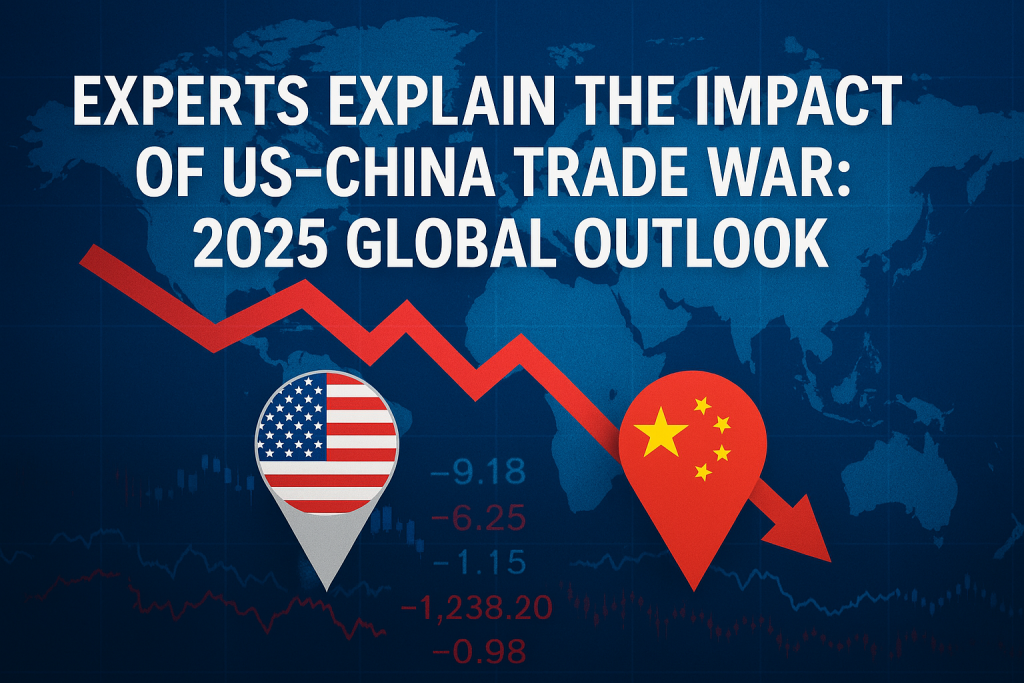The US-China trade war may have begun in 2018, but its impact is far from over. In 2025, it continues to influence global economics, supply chains, technology access, and consumer prices. For anyone navigating the global market—whether as a buyer, business owner, or investor—understanding these trends is critical.
📊 Key 2025 Trade War Statistics and Forecasts
| Indicator | 2023 Value | 2025 Projection |
|---|---|---|
| Bilateral Trade Volume | $558B | $510B |
| US Tariff Revenue (on Chinese goods) | $75B | $89B |
| Average US Household Cost Increase | +$300/year | +$500/year |
| Chinese Export Decline to the US | -6.3% | -9.8% |
| Supply Chain Risk Index | Medium | High |
Sources: Peterson Institute, World Bank, US Census Bureau
These numbers clearly indicate the continuing impact of the US-China trade war in 2025. What once started as a tariff battle has now evolved into a complex geopolitical and economic confrontation.

🧩 Global Supply Chains Are Shifting Fast
🏭 Major Manufacturers Are Moving
Tech giants like Apple and Dell are reducing dependency on Chinese factories by expanding operations into Vietnam, India, and Mexico. This diversification trend—often called the “China+1 strategy”—is aimed at reducing geopolitical risk and cost volatility.
🧾 Small Sellers Are Affected Too
Online entrepreneurs and Amazon sellers face longer lead times, increased shipping costs, and unstable inventory due to port delays and trade policy shifts.
📈 Real-World Effects of the Trade War on Consumers
💸 Higher Prices for Everyday Goods
Electronics, clothing, kitchenware, and building materials are all subject to higher prices due to tariffs on imported Chinese goods. The average American household spends an additional $300–$500 annually as a result.
📉 Investment Market Volatility
US-China tensions have added uncertainty to stock markets, especially in the tech, green energy, and semiconductor sectors. Investors must consider diversification strategies in 2025 more than ever.
⚖️ Ethical Trade Dilemmas
Countries absorbing production (like Bangladesh and Vietnam) often reduce labor or environmental protections to stay competitive. This raises long-term sustainability concerns.
🔧 5 Actionable Tips for 2025: Trade War Survival Guide
✅ 1. Track Price Trends on Key Imports
Use tools like Honey, CamelCamelCamel, and Keepa to monitor pricing trends and purchase strategically.
✅ 2. Understand Basic Trade Economics
Read accessible books like The Great Convergence and Trade Wars Are Class Wars to understand how global trade affects inflation, employment, and investment.
✅ 3. Diversify Sourcing Locations
Whether you run an e-commerce business or a retail brand, consider alternative suppliers in Vietnam, India, or Mexico to build resilience into your supply chain.
✅ 4. Adjust Your Investment Strategy
Look into:
- Southeast Asia ETFs (e.g., VNM, EIDO)
- Global logistics & automation firms
- Renewable energy and supply chain tech companies
✅ 5. Leverage Government Subsidies
Explore new subsidy programs under the US CHIPS Act, Chinese tax rebates, and ASEAN manufacturing incentives for tech and trade startups.
🧠 Business Checklist for 2025: Is Your Company Ready?
| Priority | Strategy | Why It’s Crucial |
|---|---|---|
| 🔴 High | Audit supply chain vulnerabilities | Identify risks and over-dependence on single regions |
| 🔴 High | Implement “China+1” sourcing | Reduce exposure to geopolitical disruptions |
| 🟠 Medium | Train a regional procurement team | Flexibility across Asia, Latin America, or Eastern Europe |
| 🟠 Medium | Track tariff policy shifts monthly | Adjust product pricing and logistics planning |
| 🟢 Low | Use predictive supply chain software | Improve visibility and responsiveness |
💬 What the Experts Say About 2025
“The US-China trade war didn’t end. It simply evolved. We’re now in a long-term global power contest.”
— Liu Ying, Chinese Academy of Social Sciences“Investors must embrace volatility and regional shifts as part of the new reality.”
— David Dollar, Former World Bank China Director“Businesses that prepare early will survive the next round of economic realignment.”
— Scott Kennedy, Senior Advisor, CSIS
❓ Frequently Asked Questions (FAQ)
1. Is the US-China trade war still going on in 2025?
Yes. While direct headlines have faded, tariffs remain and the conflict has shifted to technology, regulation, and global influence.
2. How does the trade war impact consumers today?
The result is higher prices for imported goods like electronics, tools, and household items, due to ongoing tariffs and disrupted supply chains.
3. Which industries are hit the hardest?
Electronics, automotive, renewable energy, semiconductors, and consumer goods have seen the most significant disruptions.
4. What is the “China+1” strategy?
A diversification tactic where companies keep some production in China but expand to other countries to reduce risk.
5. How are small businesses affected?
Smaller brands face shipping delays, higher product costs, and tighter margins due to shifting supply chains.
6. Where are manufacturers moving production?
Popular destinations include Vietnam, India, Mexico, and Eastern Europe for lower costs and fewer trade barriers.
7. Will the trade war end soon?
Not likely. Both nations are focusing on long-term strategic positioning rather than compromise.
8. What should investors do?
Diversify into Southeast Asia, watch regulatory developments, and stay alert to shifts in the tech and energy sectors.
9. Where can I learn more about global trade trends?
Visit IMF, World Bank, or read books like The Great Convergence.
🧠 Final Thoughts: The 2025 Trade Outlook Is Still Unfolding
The impact of the US-China trade war in 2025 goes far beyond tariffs. It shapes how businesses operate, how consumers spend, and how investors grow wealth. Understanding the new dynamics is the first step toward navigating this era of global economic transformation.
Don’t wait for stability—prepare for uncertainty. That’s where future opportunity lives.

